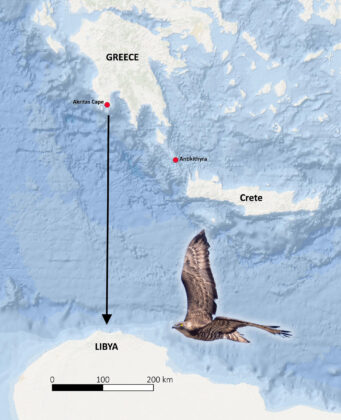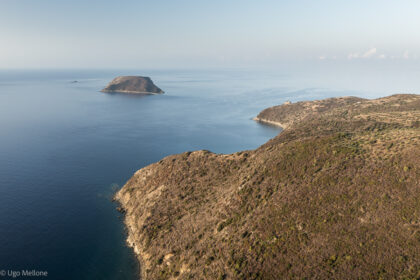Akritas Cape: a recently discovered raptor migration hotspot in the Balkans

Broad-winged raptors typically migrate where sea crossings are shorter. They primarily gather at ‘bottlenecks’ where they can cross the sea by soaring to take advantage of thermal updraughts, thereby minimising energy consumption and the risks associated with flapping flight over water. The Mediterranean Sea is crossed by numerous species during both pre- and post-breeding migrations. Historically, the main raptor migration hotspots in this region, each crossed by at least 10,000 birds in a single season, have been the Strait of Gibraltar, the Strait of Messina and the Bosphorus (Panuccio et al. 2021). These bottlenecks present both a unique opportunity and a significant risk: while they provide exceptional prospects for research, education and ecotourism, any local threats, such as infrastructure development and poaching, could have widespread effects on bird populations migrating between continents.

Several new hotspots have been identified in the past three decades, particularly in Italy, but none have approached the numbers observed at those three traditional sites. Up to now, the flyway connecting Greece with North Africa during post-breeding migration has been studied through observations from the island of Antikythira, located between southern Greece and Crete. The primary species in this area is the European Honey-buzzard Pernis apivorus, with an average of 2,796 individuals counted annually. However, we have long suspected the presence of a parallel flow, involving at least a similar number of birds, originating from the westernmost part of the Peloponnese and directly reaching Libya in a single non-stop flight of at least 420 km.

Finally, in 2024, an initial pilot count was conducted at Cape Akritas, documenting 11,790 migrating raptors in 15 days, including 11,606 European Honey-buzzards (mostly adults). To the best of our knowledge, these numbers establish this new site as the third most significant hotspot for the species in the Mediterranean region and the most important one in the Balkan area, surpassing the minimum criteria for identification as an Important Bird Area (IBA). It is remarkable that such a crucial site has remained undiscovered until now. Further counts throughout the season (until mid-October) may reveal even higher numbers, covering the peak migration of Western Marsh-harriers Circus aeruginosus and juvenile Honey-buzzards.

Fortunately, plans to construct a wind farm in the region were rejected in April 2025, potentially thanks to lobbying efforts by the Hellenic Ornithological Society (BirdLife Greece), supported by data from this study. However, the threat has not vanished. Ongoing proposals for similar infrastructure in southern Greece continue to be a significant concern, given the critical role of this region as a starting point for one of the Mediterranean’s longest sea crossings. Any rise in mortality here could impact individuals from various populations breeding across Eastern Europe, from the Balkans to Finland. To protect this vital migratory corridor, the implementation of a long-term monitoring programme, along with proactive measures to identify and address emerging threats, is urgently required.
Read the full article in Bird Conservation International here: Akritas Cape: a new raptor migration hot spot in the Balkans by, Ugo Mellone, Nikos Tsiopelas and Christos Barboutis
Book by, Panuccio M., Mellone U., and Agostini N. (eds.) Migration Strategies of Birds of Prey in Western Palearctic. (2021) available from Boca Raton: CRC Press: https://doi.org/10.1201/9781351023627






